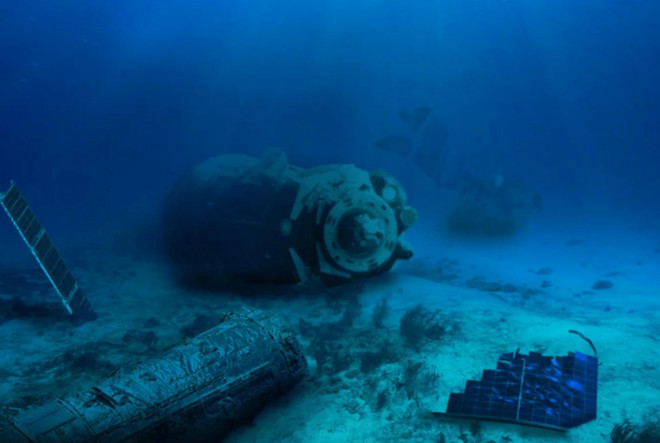Revealing the “space graveyard” of hundreds of spacecraft in the heart of the Pacific Ocean-Information Technology
About 4,800 kilometers off the coast of New Zealand and 3,200 kilometers north of Antarctica, the Point Nemo area is virtually uninhabited.
Point Nemo orbits 227 nautical miles above Earth, which is so far from land that the only people close to this area are the astronauts on the International Space Station (ISS).
It is the distance and isolation from this world that makes Point Nemo is said to be the “resting place” of the ISS when the space station ends its mission in 2030. This is also considered a “graveyard without space”. space” of hundreds of other spacecraft have been decommissioned. The Point Nemo area is named after Captain Nemo from the novel “Twenty Thousand Leagues Under the Sea” by Jules Verne since the 1970s.
In addition to the name Point Nemo, this area is also known as the Inaccessible Ocean Pole or the No-Man area of the South Pacific Ocean, the exact coordinates of the world’s most remote point have been given by the engineer with 2 bloodlines. Russia – Canada Hrvoje Lukatela calculated in 1992.
Point Nemo is Latin for “no-man’s land”, far from the mainland and almost uninhabited. Photo: The Sun
According to a 2019 study, more than 263 pieces of space debris have fallen into the region since 1971, including Russia’s Mir space station and NASA’s first Skylab space station. It is not an intact monument to the history of space travel, but possibly debris scattered over a large area.
Mr. Holger Krag, Head of the Space Safety Program Office at European Space, said: “This is the largest ocean area without any islands. It is the safest area where the falling debris”.
Point Nemo is beyond the jurisdiction of any country and is devoid of any human life here, although the area is still subject to human influence. In addition to debris from undersea space, microplastics were detected in the water when a Volvo Ocean Race yacht passed through the area in 2018.
Space debris includes old satellites that re-enter Earth’s atmosphere on a daily basis, although most of them go unnoticed because it burns up long before it can hit the ground. Of these, only larger debris – such as spacecraft and rocket components – poses risks to people and infrastructure on the ground, even if these risks are minimal. Space agencies and operators had to plan ahead to ensure that debris would land in the distant seas of Earth.
In the case of the ISS, NASA said that the space station will begin to be deployed to prepare for “retirement” as early as 2026, including lowering the altitude of the space laboratory, with it expected that it will fall back to Earth in 2031. The exact timing of the maneuvers depends on the activity of the solar cycle and its effect on Earth’s atmosphere.

Point Nemo is the “space graveyard” of hundreds of spacecraft. Illustration: ABC
Specifically, in a newly released document outlining the ISS decommissioning plan, NASA notes: “Higher solar activity tends to expand Earth’s atmosphere and increase resistance to to the ISS velocity, resulting in more drag and loss of natural altitude”.
Space agencies and commercial operators must also notify the authorities controlling flights and transports – usually in Chile, New Zealand and Tahiti – of their location, timing and size. of the areas the debris fell off.
A bigger problem than the spacecraft that ended up at Point Nemo, Mr. Krag said, was the metal rocket and spacecraft parts that caused an “uncontrolled return journey” through the Earth’s atmosphere. soil.
On average, 100-200 tons of space debris re-enters Earth’s atmosphere each year, Krag said, but most space experts consider the re-entry to be the result of an unplanned return. guess.
Much of it is above us, where it could collide with active satellites, creating a lot of trash and threatening lives on crewed spacecraft.
Specifically, according to a NASA report published in 2021, at least 26,000 pieces of space junk orbiting Earth are the size of a softball or larger and can destroy a satellite on impact; more than 500,000 marbles large enough to cause damage to a spacecraft or satellite; and over 100 million pieces of debris the size of a grain of salt that could puncture a spacesuit.
Vito De Lucia, a law professor at the Norwegian Center for Law of the Sea at Norway’s Arctic University, said space debris “landing” in Point Nemo’s ocean depths was the least worst option. . However, we don’t know much about the deep-sea environment in this area.
Some studies suggest that due to ocean currents in the area – known as the South Pacific Gyre – it is not particularly biologically diverse. Oceanographer Autun Purser, a researcher at the Alfred Wegener Institute in Bremerhaven, Germany, said he had been close to the area and said the seabed is likely inhabited by sea cucumbers, seafloor octopuses and sea cucumbers. “exotic fishes”.
“Overall it’s a low-food area, because it’s in the middle of the Pacific Gyre, a low-yield area with little nutrient-rich water, so even though there will be benthic animals,” he said. , but there probably won’t be any high biomass down there.”
Mr. Krag added that space objects that land in the ocean are usually made from stainless steel, titanium or aluminum, so are free of harmful substances. He notes that some of the rocket fuel is toxic but that they all burn up during the return to Earth. Mr. Krag said ESA is working on adding technology “designed for destruction” to replace aluminum, titanium and steel with materials that will melt as the debris re-enters Earth.
at Blogtuan.info – Source: 24h.com.vn – Read the original article here





